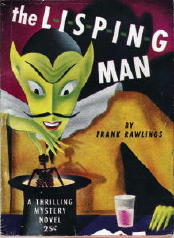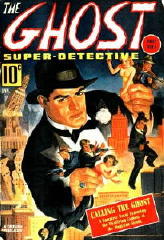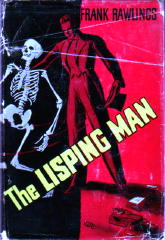Thu 26 Feb 2009
Archived Review: FRANK RAWLINGS – The Lisping Man.
Posted by Steve under Pulp Fiction , Reviews[4] Comments
FRANK RAWLINGS – The Lisping Man.

Atlas Mystery/Hercules Publishing Corp.; digest-sized paperback; first printing, 1944; abridged. Hardcover edition: Gateway Books, 1942. Based on the short novel “Calling the Ghost,” the first appearance of the Ghost/Green Ghost pulp hero character, magician-sleuth George Chance, in The Ghost, Super-Detective, January 1940, as by G. T. Fleming-Roberts.
For a longer and much more comprehensive look at the complicated background behind this story, go to Monte Herridge’s excellent article “Chance Without a Ghost,” located here. Monte goes into a considerable amount of detail in pointing out all of the changes that were made by Fleming-Roberts between the pulp story and the digest paperback, with a hardcover appearance in between.
The most significant of these alterations turned out to have been all of the pulp hero apparatus that was abandoned for the novel — no secret identity nor hidden hideaway nor so on — leaving George Chance as only a magician by profession and a crime-solving sleuth as a sideline, only one step up from being a hobby, you might say.
Monte did not believe that the story was very good.
I agree. In fact, I thought it was quite bad, if not awful, but with reservations. Working pretty much in the dark, I’m inclined to lay a good chunk of the blame on the second set of changes: on whoever the editorial staff was whose responsibility it was for trimming a standard-sized hardcover down to a fairly slim paperback. The latter is the only version I have, and as it was for Monte, that’s all that I can base my comments on.
So how much was cut, or whether it was done crudely or with any amount of skill, I do not know. The fact is that when a book is cut and trimmed and comes out as, well, ineptly as this one, it’s difficult to give the full responsibility to the author for how the final version reads, especially as in this case, when it does not turn out well.
[FOLLOWUP: It’s not exactly a footnote, but Bill Pronzini, a fellow pulp fiction aficionado, will have more to say about this when I’m finished with the rest of the review, which follows. Keep reading.]

I mentioned that crime-solving was an avocational passion for George Chance. A good example that I can use to demonstrate just exactly how obsessive and attracted Chance is to strange murder cases comes only one or two chapters into the book, as he leaves his new wife Merry on their wedding night to help Inspector Ames investigate the suicide of one Leonard Van Sickle, who apparently jumped (or was pushed) from a hotel room twenty floors above the pavement.
What makes this a strange case is that Leonard Van Sickle had telephoned Chance only hours before, with no indication in the call that he was planning on ending his life. What is also strange is that he talked with a lisp. Hence the title. It also turns out (page 67) that the dead man had recently had all of his teeth extracted.
Explains the dentist:
As you have probably suspected, there is something funny about it, all right, and you also would probably not be astonished to learn that there is a lot of fuss made about life insurance policies and who collects and who doesn’t.
There is some intelligence behind the plot, but it is seemingly indifferently and/or non-skillfully told most of the way through, culminating in a “gather all of the suspects together” scene that does not depend on more than a modicum of a magician’s sleight-of-hand in any substantial manner, shape or form.

What it does rely even more upon is the answer to the question, “Whose hands will show up like phosphorus under an ultra-violet light?”
It didn’t take a magician to think of this. I think that if a magician is a sleuth, he ought to do more with his prestidigitation and legerdemain than pull cigarettes out of the air or coins out of people’s ears. (I’m speaking figuratively here, as what is up George Chance’s sleeve at a crucial moment is, well, crucial.)
There is a decent detective novel hidden in the depths of this one, perhaps. I just didn’t happen to read it, or I was too lazily intent at the time on reading the one that was there, not the one it could have been.
FOLLOWUP: After finishing my review above, and telling Bill Pronzini only the gist of what I’d said, I asked him about the differences between the hardcover and the paperback version of the novel. (I could think of no one else who might possibly have read both.) Here’s his reply:
February 27th, 2009 at 10:22 am
Steve, there appears to be a 1946 PRC cheapie called LADY CHASER (d. Sam Newfield) credited to ‘story by’ G.T. Fleming-Roberts (a girl accused of poisoning her wealthy uncle tracks down real murderer).
Has anyone ever seen this film…? If so, what thoughts?
Tise
February 27th, 2009 at 4:42 pm
Tise
Monte Herridge quickly points out that he mentioned the movie in his article about GTFR on the primary M*F website, where he said:
“Blackmail With Feathers,” a 34-page story published in the August 1942 issue of Detective Novels, was one of his more successful stories. It was made into a movie by Warner Brothers in 1943 — FIND THE BLACKMAILER — starring Jerome Cowan and Faye Emerson. A 1946 film, LADY CHASER (also known as LADY KILLER), starring Robert Lowery, Ann Savage and Inez Cooper, was based upon the 22-page story “Lady Killer,” published in the July 1945 issue of Detective Tales.
As to whether anyone’s seen either movie is a question as yet unanswered.
— Steve
February 27th, 2009 at 5:57 pm
Steve,
I saw FIND THE BLACKMAILER some years ago, and found it very disappointing. Not offensive: just a routine whodunit without much craft or charm.
Did not pay any attention at the time to any G.T. Fleming-Roberts connection.
August 6th, 2010 at 9:58 pm
[…] Previously reviewed on this blog was The Limping Man, by Frank Rawlings, a pen name of G. T. […]